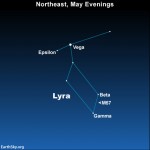
Vega is a lovely star to come to know. When I was first learning the night sky, more than 40 years ago, I spent hours, days, weeks, months poring over charts and books. So I sometimes came to know the names and whereabouts of certain stars before seeing them in the night sky. One soft May evening, I happened to glance toward the northeast. I was thrilled at the sight of Vega – gleaming sapphire-blue – and surprisingly bright for being so low in the sky.
Look for this star tonight. It’s the fifth brightest star in our sky. If you’re in the Northern Hemisphere, you’ll find beautiful, bluish Vega easily, simply by looking northeastward at mid-evening in May. Vega is so bright that you can see it on a moonlit night.
From far south in the Southern Hemisphere, you can’t see Vega until late at night in May. That’s because Vega is located so far north on the sky’s dome. Vega will reach its high point for the night around three to four hours after midnight, at which time people in the Southern Hemisphere can see this star in their northern sky. As seen from mid-northern latitudes, the star shines high overhead at this early morning hour.
Because it’s the brightest star in the constellation Lyra the Harp, Vega is sometimes called the Harp Star. Like all stars, Vega rises some four minutes earlier each day as Earth moves around the sun. So Vega will ornament our evening sky throughout the summer and fall.
Although Vega is considered a late spring or summer star, it’s actually so far north on the sky’s dome that – from mid-latitudes in the Northern Hemisphere – you can find it at some time during the night, nearly every night of the year.
Enjoying EarthSky so far? Sign up for our free daily newsletter today!

View at EarthSky Community Photos. | Here’s Vega as seen around 3 a.m. from Valencia, Philippines, on May 10, 2019, from our friend Dr Ski. See Vega’s beautiful blue color? Notice the star near Vega, marked the Greek letter Epsilon. This star is Epsilon Lyrae, a famous double-double star.
Bottom line: It’s easy to identify the star Vega in the constellation Lyra at this time of year. From the Northern Hemisphere, look northeast in the evening for a bright, bluish star above the northeastern horizon.
from EarthSky https://ift.tt/3bEdY3r

Vega is a lovely star to come to know. When I was first learning the night sky, more than 40 years ago, I spent hours, days, weeks, months poring over charts and books. So I sometimes came to know the names and whereabouts of certain stars before seeing them in the night sky. One soft May evening, I happened to glance toward the northeast. I was thrilled at the sight of Vega – gleaming sapphire-blue – and surprisingly bright for being so low in the sky.
Look for this star tonight. It’s the fifth brightest star in our sky. If you’re in the Northern Hemisphere, you’ll find beautiful, bluish Vega easily, simply by looking northeastward at mid-evening in May. Vega is so bright that you can see it on a moonlit night.
From far south in the Southern Hemisphere, you can’t see Vega until late at night in May. That’s because Vega is located so far north on the sky’s dome. Vega will reach its high point for the night around three to four hours after midnight, at which time people in the Southern Hemisphere can see this star in their northern sky. As seen from mid-northern latitudes, the star shines high overhead at this early morning hour.
Because it’s the brightest star in the constellation Lyra the Harp, Vega is sometimes called the Harp Star. Like all stars, Vega rises some four minutes earlier each day as Earth moves around the sun. So Vega will ornament our evening sky throughout the summer and fall.
Although Vega is considered a late spring or summer star, it’s actually so far north on the sky’s dome that – from mid-latitudes in the Northern Hemisphere – you can find it at some time during the night, nearly every night of the year.
Enjoying EarthSky so far? Sign up for our free daily newsletter today!

View at EarthSky Community Photos. | Here’s Vega as seen around 3 a.m. from Valencia, Philippines, on May 10, 2019, from our friend Dr Ski. See Vega’s beautiful blue color? Notice the star near Vega, marked the Greek letter Epsilon. This star is Epsilon Lyrae, a famous double-double star.
Bottom line: It’s easy to identify the star Vega in the constellation Lyra at this time of year. From the Northern Hemisphere, look northeast in the evening for a bright, bluish star above the northeastern horizon.
from EarthSky https://ift.tt/3bEdY3r

Aucun commentaire:
Enregistrer un commentaire